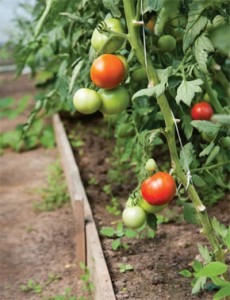 Q. Why should I prune my tomato plants? I’ve been told I should. They’re in cages and seem to be thriving with tomatoes nearing maturity. In addition, can I save the seed from these plants for next year?
Q. Why should I prune my tomato plants? I’ve been told I should. They’re in cages and seem to be thriving with tomatoes nearing maturity. In addition, can I save the seed from these plants for next year?
A. Yes, tomatoes are pruned but not like a rose, fruit tree or hedge. It’s better described as a thinning by removing the side shoots of each plant. With the indeterminate tomato varieties, this is an important practice throughout the growing season while the determinate varieties have a shorter growing season that lessens the necessity to thin. Indeterminate plants are a vigorous grower creating very dense conditions in cages. The dense growth can lead to several cultural issues over their prolonged growing season. The lack of light forces the center of the plant into permanent shade, causing the foliage to discolor and fall off. The lack of sunlight minimizes or eliminates photosynthesis from occurring in these leaves. Photosynthesis is critical in forming the green pigment, chlorophyll and plant sugars. Most of the sugar is directed toward the production of tomatoes. An excessive amount of vegetation increases the number of smaller sized fruits. Thinning or removing the side shoots increases the amount of light into the center of the plant. This growth is found emerging next to a leaf where it is attached to an established stem. Typically, this is done throughout the spring and summer months. There are no set rules as to how much or how often this would be done. It’s strictly a judgment call on your part. Another reason for opening up the plants, it makes it easier to spot the early damage from Tomato Hornworms. Tomato Hornworm is a green segmented, worm that can be a problem June through September. Hornworm is the larva stage of the Sphinx Moth and you can have multiple infestations each year. Their green color makes it easy for them to blend into the foliage. You need to be on the lookout for them now. The worms can strip a plant quickly of leaves exposing the maturing tomatoes to Sunburn damage.
You can save the tomato seed for planting next year. But that’s the wrong question to ask. The question should be; Is this a variety worth the time and effort to save? All tomato plants produce seed but not all varieties are predictable from year to year. The genetic characteristics of hybrid varieties vary greatly in the seed they produce. The only way to exactly duplicate these varieties is to plant new seed. Hence, it’s not suggested or recommended saving seed from hybrid varieties as you’ll more than likely be disappointed with the results. This is not the case with the open pollinated varieties. They are genetically stable as many of these varieties have been around for decades. If you’re not sure what you have contact your favorite garden center. They can help out with questions concerning indeterminate, determinate, hybrid and open pollinated varieties.
Buzz Bertolero is Executive Vice President of Navlet’s Garden Centers and a California Certified Nursery Professional. His web address is www.dirtgardener.com and you can send questions by email at dirtgarden@aol.com or to 360 Civic Drive Ste. ‘D’, Pleasant Hill, Calif. 94523 and on Facebook at Facebook/.com/Buzz.Bertolero
Does the Dirt Gardener still have a radio program? If so, when is it?